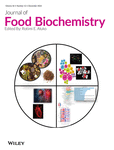6- shogaol suppresses AOM/DSS-mediated colorectal adenoma through its antioxidant and anti-inflammatory effects in mice
Abstract
Colorectal adenoma appears as benign lesions and is a precursor of colorectal adenocarcinoma. The effect of 6-Shogaol (6-[S]), a bioactive agent from ginger, in early colonic adenoma growth is unknown. As a result, this study examines the effect of 6-[S] in a mouse colorectal adenoma model induced by Azoxymethane (AOM) and dextran sulfate sodium (DSS). Adult male mice served as control in Group 1. Group 2 was treated orally with 6-[S] extract (20 mg/kg BW). Group 3 was exposed to AOM (25 mg/kg BW, ip) and one cycle of DSS (2.5%) in drinking water alone while Group 4 was co-treated with 6-[S] for twenty-one (21) days. The body weight gain, organ weight and length, oxidative stress indices, inflammatory markers and histological examination were estimated. Our findings show that 6-[S] co-treatment reversed AOM/DSS-induced elevation in colon weight, colon length, nitric oxide (NO), myeloperoxidase (MPO), hydrogen peroxidase (H2O2), and tumor necrosis factor-alpha (TNF-α). However, the antioxidant enzyme activities measured namely catalase (CAT), superoxide dismutase (SOD), reduced glutathione (GSH), and glutathione-S-transferase were significantly increased in 6-[S] treated mice. Taken together, the protective effect of 6-[S] on oxidative burden, inflammation, and histological aberration observed in the colon of the AOM/DSS model of adenoma growth in mice is mediated primarily owing to its anti-inflammatory and anti-oxidative properties. Thus, this study reveals 6-[S] as a useful agent in the possible clinical intervention of colorectal adenoma.
Practical applications
Certain spices have been reported to have numerous phytochemicals with numerous medicinal purposes. However, no studies have been conducted to investigate the role of 6-[S], a phytochemical found in ginger, in the treatment of colorectal adenoma. The study's findings show that 6-[S] is protective in early colonic cancer development, as it manages colorectal adenoma cancer models of AOM/DSS. As a result, 6-[S]’s ability to reduce oxidative stress and inflammation in the colon may be a potential nutritional therapeutic adjuvant for colorectal adenoma.
CONFLICT OF INTEREST
The authors declared that they have no conflict of interest.
Open Research
DATA AVAILABILITY STATEMENT
The data that support the findings of this study are available from the corresponding author upon reasonable request.




